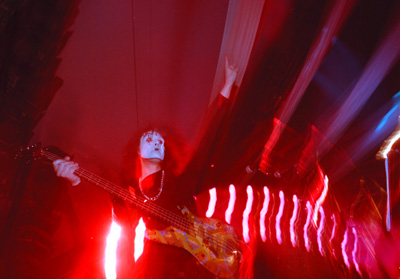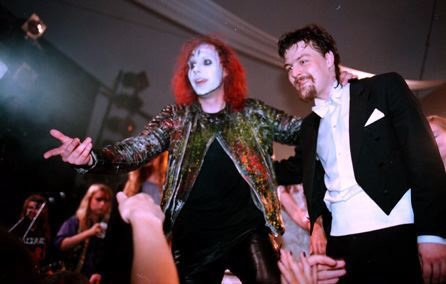Yeah! Yeah! Die! Die!
Death Metal Symphony In Deep C
Performed live with Avanti! Symphony Orchestra 1995 in Helsinki
CD released in Finland, Germany, Austria and Switzerland 1996
Performed live with Turku Symphony Orchestra 1997 in Turku
The Story : Part 2

Q: Is this more ”classical” than ”modern” music for symphony orchestra?
Riku: it’s classical music with modern elements...
Kärtsy: The band represents the modern...
Riku: The whole work is influenced by classical music - mixed freely with modern elements.
Kärtsy: I would call it pop!
Q: Kärtsy told me that as a child he listened to Beethoven at home...
Riku: So it seems, there’s a lot of influence from Beethoven here, and also from Wagner.
Kärtsy: I never listened to Wagner at home.
Riku: But Sibelius for sure...
Kärtsy: or rather John Lord (the keyboard player of Deep Purple)! I’ve heard that he got influences from Sibelius.
Riku: And Sibelius was a great admirer of Wagner.
Kärtsy: Yes, we went through all that at Sibelius High School during the lessons of History of Music.
Riku: Musorgski is also there... and Beethoven very strongly; not straight his music but the atmosphere.
Q: The classical part is very romantic...
Kärtsy: Yes, that’s true.
Riku: Mahler is present in some parts and the waltz reminds of Sostakovits.
Kärtsy: I composed the waltz during summer -93. I had already made heavy metal parts and wanted to add some pure classical ideas... crossover feeling. Also the bonus track was composed during the same day; in fact half of The Symphony! Naturally it took lots of more time to get these ideas organized, but anyway - the basic consept was there.
Q: So then you worked on these ideas and told the other guys in Waltari about the plan?
Kärtsy: Yes, I told them, but we all knew that it’s a miracle if we can realize it somehow... finally - when we had agreed to perform it at Helsinki Festival - the organizers became a bit nervous when we told them that ”hey, a few musicians is not enough, we need an Orchestra with a big O!”
Riku: Yes, they looked at me like ”oh, no, here’s the trouble maker again”, but if you do something you better do it properly. In this connection I want to emphasize that this was not an expensive project after all. Helsinki Festival was run at a loss and some people might have though that Death Metal Symphony - a rock band and a symphony orchestra staged in an impressive way - was eating loads of cash, but this is not true.
Q: Well, if I remember correct, it wasn’t mentioned as one of the reasons for the losses anywhere...
Riku: No, it was not mentioned, but it was shown on the background on TV when they were discussing the losses. Of course we weren’t cheap, because there was so many people involved, but no one got rich. And you shouln’t forget that the show in the Festival Tent was sold out!
Q: Ok, maybe it’s time summarize a bit what has happened so far. How did you start to work your way from the level of ideas into practice?
Kärtsy: I met Riku at Restaurant Vanha right after I had returned back in town from recording of ”Big Bang”. We decided that we do it, so I marched home and composed Part I. I just put on my tape recorder and started jamming with synths. At that moment I also decided that spring -95 is devoted to The Symphony, because I knew that we were about to change record company and ”Big Bang” would not be released before autumn. Then I told the other band members that rehearsals start straight after New Year - and so they did. I started rethinking all of the material, in a way composing it all over again in a chronologial order... from the beginning to the end... the last part was composed last. As I told you before, there was a lot of ideas... and a lot was also left out. I had many peaceful, calm parts; first it was meant to include 12 parts; but then I cut it down to 8, or 9 to be exact.
Q: How did you compose the music for the band? With an acoustic guitar?
Kärtsy: First I wrote it all down on a piece of paper at home: what comes now and how many times... second by second I went through the stuff I had recorded on Tenhola, made some more... Part I found it’s form quite spontaneously, in fact the whole symphony did. Then I made a structure to for example Part II and presented it to the guys at the rehearsal place. This was the decisive moment: Waltari had never played this kind of material before and I was wondering if we able to do it... To remember all the hooks and turns... no one of us can read notes!
Riku: It’s also essential that Kärtsy knew that it won’t be possible to make big changes after he has finalized the structures and made a demo of it. I listened to the demo and wrote first a score for piano and then for symphony orchestra.
Q: How long did it take?
Riku: I won’t tell you, it’s a professional secret (ha-ha)! ...well, when I work, I usually work 24 hours a day... it took some time, but, no, I won’t tell you how long.
Kärtsy: I thought in the beginning that I’ll be able to do most of the work during January, because there was not really anything else happening, but soon I realized that it’s not possible. By the end of the month I had finalized only 3 or 4 parts, because I found myself investigating different sollutions in order to find the best one. With the band we rehearsed in short parts; for example playing the beginning of Part II as long as we knew it from the heart and then recorded it. And after that another 2 - 3 minutes...
Q: What were the band members’ first reaction?
Kärtsy: Hmm... I don’t remember. For sure we had discussed this crazy dream of mine earlier... Maybe they would have liked to take part in composing somehow, but then I explained that I have a very clear idea how to build this... that it would not really make sense for everybody to take part in the process because of all the arrangements for an orchestra and all that.
